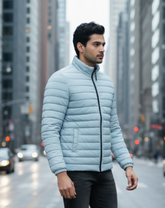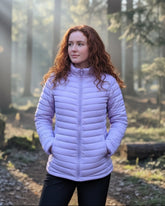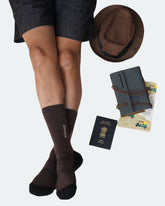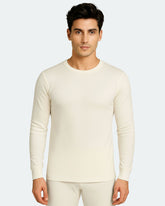Surviving Russian Winters: A Student’s Guide to Layering
Effective layering for your cold outings. Let’s get straight to the point.
You’re probably reading this article if you’re a student traveling to Russia for higher education. Or you could be just traveling to Russia or any other country with extremely cold weather. In either scenario, you’re looking for the right combination of clothing to pack. Well, in that case, you’ve come to the right place.
In this article, we’ll go over the layering basics and provide the best tips on how you can customize your clothing to suit the freezing Russian winters you’re about to experience. We won’t compromise on fashion either, so we’ll include some stylish tips too. The Russian Winter is often personified as General Frost. Winter in Russia varies greatly from one place to another. On average, temperatures often dip down to below ‑40°C in Yakutia. In Moscow and St. Petersburg, winter temperatures range from about ‑10°C to ‑20°C.
The Layering Basics

The basic layering system you use for winters in tropical countries is also applicable here.
Here’s a shorter breakdown of it:
The Base Layer: To keep you warm and dry, and wick off moisture and sweat from your body. This layer is basically your inners and thermals.
The Middle Layer: This layer’s basically there to hold in your body heat by providing enough insulation. The better the heat trapping, the warmer you’ll be. This layer consists mainly of sweaters and sweatshirts.
The Outer Shell Layer: This is the layer that’s exposed to the elements and shields you from wind, rain, and snow. The outer layer is your puffer or fleece jackets, or coats, depending on which you opt for.
The Base Layer

A base layer, often referred to as thermal underwear or long johns, is primarily designed to provide warmth. It works by trapping a layer of air next to the skin, which is then warmed by body heat, creating an insulating effect. The base layer of your clothing also has a second important function: to get rid of sweat so it doesn’t cool on your skin later. It doesn’t matter if it’s freezing out, the innermost layer should be the thinnest and the most comfortable. The human body is always sweating. No matter how cold you are, you’re always losing some water. This water evaporates along with some amount of heat from your body.
You don’t need things to be hefty and coarse close to your skin. A thin, snug and warm thermal thin, snug, and warm thermal will effectively keep you comfortable, wick sweat better, and get dry faster. When planning your stay in Russia, we recommend a good Merino wool thermal for your base layer. Thermals usually have a two-ply fabric, so they keep you warmer than regular base layers. Alternatively, you can also go for natural fibers. This applies to both tops and bottoms. Make sure your materials are soft and lightweight and fit close to your body. The inner layers must be the most comfortable ones, as they’re in direct contact with your skin. The winter thermals you choose must be designed to keep the “core” of your body warm. When the torso is kept warm, it becomes easier to maintain warmth throughout the rest of the body. Joint areas, like knees, are particularly susceptible to freezing in the extreme cold and need to be well-protected.
TIP! Keep a few thermals to wear when you’re in covered or warm areas, like your hostel room. These might also come in handy if you’re looking for things to wear inside your hostel or during the daytime. You might also want something to wear indoors that’s lighter than the regular thermal but still offers solid warmth. In that case, consider a half-sleeved thermal tee.
The Middle Layer: Sweaters, Sweatshirts, and Hoodies

Your middle layer will include sweaters and sweatshirts. Make sure that your middle layers are light and breathable. Heavy materials can weigh you down, restrict your movement, and make you feel needlessly bulky.
The middle layer insulates your body heat, trapping it between your thermal and shell. Pick out light mid-layers so they can perfectly go in between your inners and outers. For lightweight yet insulating options, explore Kosha’s Fleece Lined Sweatshirt For Men – designed to lock in warmth without bulk, making it ideal for students facing harsh Russian winters. Common materials for middle layers include fleece and synthetic insulation. The effectiveness of the middle layer ensures that the warmth generated by your base layer is retained, keeping you comfortable in cold conditions.
The Outer Layer: Jackets and Coats

The average annual snowfall in Russia varies significantly depending on the region you’re visiting due to its vast size and diverse climates. In Moscow, the capital city, it snows for approximately 72 days a year, with the most snowfall occurring in January, which typically has about 18 snow days.
Expect 17 to 18 snow days per winter month. There’s a combination of high humidity levels, snowfall, and a lack of sunshine. The outer layer protects you from exposure to the elements: snow, rain, and wind. This shell layer has to be a solid wall between you and the harsh Russian climates, so choose wisely. Always ensure that your outer layer is wind-proof, waterproof, and warm. You don’t want melted snow seeping into your inner layers. A Russian winter is no joke, so we recommend a hooded thick jacket. Try Kosha’s Alaskan Parka Jacket For Women for superior warmth, wind protection, and functional design built to handle temperatures as low as -20°C.
When styling, you can choose either fleece or puffer jackets. For formal occasions, consider a classy look with trench coats and overcoats. Kosha jackets are the best option!!!
Accessories
At this point, you’re probably all bored with the layering system. You’re probably afraid that half of the colorful things you chose for styling won’t even show from within your heavy shell layer. This is where we come to accessories.
When styling, you can go for either fleece or puffer jackets. You can also go for a classy look with trench coats and overcoats for formal occasions. Among the accessories are your socks, gloves, scarves, and beanies. Carrying at least a few sets of all of these is a must. After all, it is a Russian winter, not a regular one.
Socks

Gear yourself up with the warmest socks you can get your hands on. As they say, warm limbs mean a warm body. In fact, cold hands and feet are often a sign that your body is trying to maintain its regular body temperature. For everyday layering that blends elegance and insulation, Kosha’s Herringbone Business Socks for Men offer both style and functionality in sub-zero climates. The layering principle also goes for your socks. So if you find temperatures dipping too low and one pair of socks isn’t enough, go for two pairs.
Make sure that the fibers you buy provide extreme comfort and can be worn between -5°C to 15°C. Prioritize comfort, flexibility and softness over less prices. You can go for 100% merino wool, wool blend, and even extra-fine Merino Wool, in ravishing bright colors to keep your toes warm and your feet happy and blister-free.
Gloves and Mittens

Great gloves are more important than they seem at first glance. Imagine yourself in a few months, standing before the Kremlin, trying to take a picture to share on your Instagram feed.
You take off your gloves to click on your touchpad and get frostbitten fingers that won’t move at your command. You don’t want that. Get yourself a couple of sets of screen-friendly and touchscreen-enabled winter gloves. This way, your fingers will stay warm, and you’ll also be able to operate your electronic devices with perfect ease. For younger travelers or students, Kosha’s Boys Merino Wool Knitted Mittens provide superior softness and thermal protection ideal for long walks in frosty streets.
Caps and Beanies
Your caps and beanies don’t only give you the cool, classic college-goer look. They also keep your ears cozy and your head covered against the freezing cold temperatures. Needless to say, look for the softest and most comfortable fabric you can find. You will be wearing your beanie almost 24/7 when you’re in Pittsburgh or Moscow, and you don’t want any sort of itchiness in your ears or against your forehead and scalp.
Go for a pure wool beanie, and don’t settle for low-priced, low-quality materials. Bad quality wool might be easy to find and low-priced, but in the long run, they become more or less impossible to wear regularly.
Scarves and Mufflers
When going abroad, make sure that your throat is secured first from the extreme cold temperatures. If drinking water needs to be warmed before having, you definitely need to cover your neck. Scarves also help when it’s windy outside. Covering your face when there’s a chilling wind is just another plus of a warm pure wool scarf.
If you think the puffer jackets and overcoats make you look hefty, mufflers are always in style. Go for edgy and bright designs in mufflers and scarves in 100% Merino wool. Merino wool is versatile and regulates your temperature, making sure you’re never too hot and never too cold. It’s soft, warm, and keeps you cozy at all times of the day.
Shoes
Rest assured that the Russian roads will be wet with snow in the winters. You need to carefully pick non-slippery warm boots, preferably those with an inner lining that protects your feet from harsh cold. Make sure the soles are thick and non-slippery, with detailed grooves.
Top 5 Tips for Staying Warm and Comfortable in Winter
Tip #1: Choose the Right Layers When selecting layers, it's crucial to remember that the problem isn’t just staying warm—it's avoiding getting too warm and sweaty. Your layers should keep you dry, warm, and protected from the wind. Opt for moisture-wicking base layers, insulating mid-layers, and windproof outer layers to maintain the perfect balance.
Tip #2: Avoid Bad Quality Fabrics Poor-quality clothing and fabrics can create static electricity between your layers, making your hair stand up. This can leave you feeling sweaty and cold simultaneously. Invest in high-quality, breathable fabrics that help regulate your body temperature and reduce static build-up.
Tip #3: Say No to Skinny Jeans Forget about skinny jeans! Tight clothing allows cold air to pass through, defeating the purpose of layering. Always keep a layer of warm air between your clothing and your body. Baggy clothing is better as air acts as an insulator, helping to keep you warm.
Tip #4: Snug Your Scarf Tuck your scarf into your coat or jacket to prevent any air from seeping in. If it gets extremely cold, wear your scarf over your beanie or cap and around part of your face. This creates an additional layer of fabric that protects your head and face from the winter chill.
Tip #5: Choose High Shoes Opt for high shoes rather than just thickly lined ones. Higher shoes ensure that you can step into deep snow without letting it come into contact with your socks and feet, keeping them dry and warm.
FAQs
Q: How do Russian people survive in winter?
A: Russians use double panes of glass in their windows for insulation. For extra protection, many houses have shutters to cover the windows. The roofs are steep so snow slides off easily. Russians never let their climate stop them from enjoying outdoor activities. They prefer waterproof boots paired with several pairs of wool or fleece socks. Additionally, Russians use the three-layer clothing system to stay warm, stacking up layers to retain heat effectively.
Q: Which is the no. 1 coldest city in the world?
A: Yakutsk, Russia, the capital city of the vast Siberian region known as the Sakha Republic, is widely identified as the world's coldest city. Temperatures can drop below minus 50 degrees Celsius in the height of winter.
Q: How do you dress for Russian winter?
A: To dress for a Russian winter, start with a solid thermal 2-ply base layer. Avoid cotton products, as they soak up sweat and become wet quickly; instead, opt for wool or polyester. Use a fleece or puffer jacket as a mid-layer. Top your base and mid-layers with a long, thick, and warm hooded outer shell layer that traps heat. Complete your outfit with a beanie and a warm woolen muffler. Ensure these accessories are soft to avoid itching and discomfort when in contact with your face. Use one or two layers of socks depending on the cold, and wear high-lined boots to keep your feet warm.
Q: Why is Yakutia so cold?
A: Yakutsk is situated along the banks of the Lena River, and the valley it occupies tends to confine cold air. In winter, Siberia experiences a high-pressure system called the Siberian High, which brings in frigid air masses from the Arctic, resulting in prolonged periods of severe cold.
Conclusion: Wrapping Up
Surviving the harsh winters of Russia, particularly if you are a student planning to study or travel there, involves more than just enduring the cold; it means adapting to it strategically and comfortably. With the right clothing strategy, you can turn the formidable Russian winter into a season of exploration and wonder, without sacrificing comfort or style.
Understanding the importance of layering is fundamental to conquering the cold. The three-layer clothing system, consisting of a base layer, a middle layer, and an outer shell, is a proven approach to maintain body warmth and comfort in freezing temperatures. The base layer keeps your skin dry by wicking away moisture, an essential feature because even in frigid temperatures, your body continues to sweat. Opting for materials like Merino wool for your base layer can provide exceptional warmth and moisture management. The middle layer serves as the primary insulating component, trapping body heat to keep you warm. Lightweight and breathable materials for this layer, such as fleece or quality synthetic fibers, ensure that you stay insulated without feeling bulky or restricted in your movements. This layer can be adjusted based on the day's temperature, allowing flexibility and adaptability in your daily attire.
The outer shell is your first line of defense against the elements. It needs to be robust enough to ward off wind, rain, and snow while maintaining breathability to prevent overheating. The characteristics of an ideal outer shell include being windproof, waterproof, and equipped with a hood for added protection. Aesthetic considerations also come into play here, as this layer is the most visible and offers the opportunity to express personal style. Beyond these three core layers, accessories like socks, gloves, hats, and scarves play crucial roles in keeping extremities warm. They fill in any gaps in your armor against the cold, ensuring that areas like your neck, hands, and ears are protected from the chill. Accessories like socks and muffs not only offer additional warmth but also add color and personality to your winter attire.
Avoiding tight-fitting clothes like skinny jeans, which can restrict the insulating layer of air around your body, and opting for looser, breathable fabrics can make a significant difference in your comfort. High boots, layered socks, and waterproof outerwear are essential for navigating snowy and icy environments, keeping you dry and warm from head to toe. Russian winters, though challenging, also bring unique experiences and breathtaking snowy landscapes. With the right clothing strategy, these months can be enjoyed rather than merely endured. The beauty of a snow-covered Red Square or the crisp air of a Siberian morning are experiences that, when properly dressed, become cherished memories rather than uncomfortable challenges.
In conclusion, the key to thriving in Russian winters lies in understanding and implementing effective layering techniques. By choosing the right materials, adhering to the three-layer system, and complementing your outfit with essential accessories, you can stay warm, dry, and comfortable. Shop your complete winter layering needs with Kosha – India's trusted brand for sustainable and stylish winter wear built for extreme climates like Russia.Embrace the opportunity to experience one of the coldest but most magical parts of the world in total comfort, equipped with the knowledge and the gear to fully enjoy everything Russian winter has to offer.
Editor’s Picks
Packable Puffer Jacket For Men
- From ₹3,900.00
₹8,400.00- From ₹3,900.00
- Unit price
- / per
Men's Full Sleeves Thermal | Merino Wool + Bamboo
- ₹4,940.00
₹7,600.00- ₹4,940.00
- Unit price
- / per
Alaskan Parka Jacket For Women - Slim Fit
- ₹8,925.00
₹11,900.00- ₹8,925.00
- Unit price
- / per
Lightweight Packable Puffer Jacket For Women
- ₹6,300.00
₹8,400.00- ₹6,300.00
- Unit price
- / per
Men's Merino Wool Cushioned Technical Socks
- ₹1,074.00
₹1,790.00- ₹1,074.00
- Unit price
- / per













